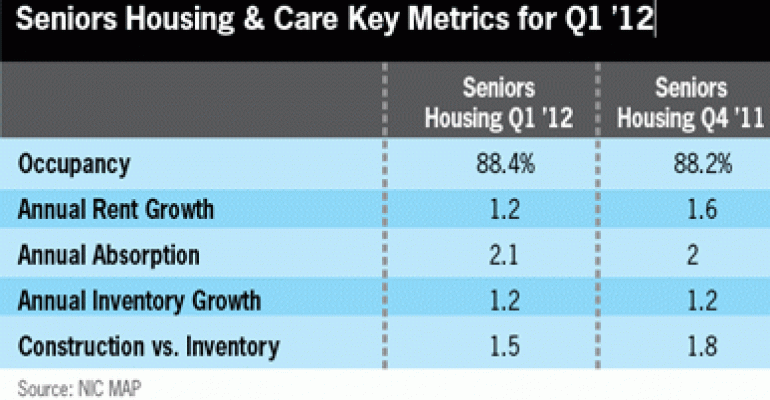The seniors housing occupancy rate continued its gradual recovery in the first quarter of 2012, reports the National Investment Center for the Seniors Housing & Care Industry (NIC). However, construction activity and year-over-year rent growth slowed, according to NIC MAP, a data analysis service.
Overall, the average occupancy rate for seniors housing properties in the first quarter of 2012 was 88.4 percent, an increase of 0.2 percentage points from the prior quarter and a 0.8 percentage point increase from a year earlier. The seniors housing average occupancy rate has risen consistently during the past eight consecutive quarters and is currently 1.3 percentage points above its cyclical low of 87.1 percent in the first quarter of 2010.

The occupancy rate for independent living properties in the first quarter of 2012 averaged 88.3 percent, and the occupancy rate for assisted living properties averaged 88.6 percent. Both independent and assisted living properties showed improvement over the previous quarter, rising 0.3 and 0.2 percentage points, respectively. The average occupancy rate for independent living is now 1.3 percentage points above its respective cyclical low.
Annual rent growth slows
Annual rent growth for seniors housing slowed to 1.2 percent, from 1.6 percent in the fourth quarter of 2011, remaining unchanged from the pace in the first quarter of 2011. This slowdown has been caused by a number of factors, according to Michael Hargrave, vice president, NIC MAP.
“Asset values such as housing, investment and incomes have seen declines and/or slower growth rates which has, in turn, resulted in a challenging pricing environment for seniors housing operators and is likely the main reason why we are seeing below inflationary level annual rent growth,” says Hargrave.
Annual absorption rises slightly
For seniors housing properties, annual absorption rose slightly to 2.1 percent in the first quarter of 2012, compared to 2.0 percent in the fourth quarter of 2011 and 1.0 percent in the first quarter of 2011. According to NIC MAP, this is the sixth consecutive quarter in which the pace of annual absorption is above that of annual inventory growth.
The seniors housing annual inventory growth rate was 1.2 percent in the first quarter of 2012, which is unchanged from the fourth quarter of 2011 and a year earlier. Current construction as a share of existing inventory for seniors housing was 1.5 percent, down from 1.8 percent in the prior quarter.
Hargrave says he expects to see similar current absorption and inventory growth patterns over the next two quarters. “The current level of annual inventory growth—1.2 percent—is near a cyclical low and allowing modest, but upward pressure on occupancy,” he says.
Nursing care continues gradual decline
The nursing care occupancy rate was 88.2 percent in the first quarter of 2012, unchanged from the previous quarter, continuing its moderate decline over the past several years. Nursing care annual inventory growth was -0.3 percent in the first quarter of 2012, and private pay rents for this sector grew 3.0 percent year-over-year, slower than the 3.4 percent pace reported in the fourth quarter of 2011.

